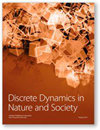投稿信息
稿件收录要求
The main objective of Discrete Dynamics in Nature and Society (DDNS) is to foster links between basic and applied research relating to discrete dynamics of complex systems encountered in the natural and social sciences. Discrete dynamics reflects a new emerging tendency towards utilization of iterative mathematical models systems of difference equations to describe the behavior of complex systems. It has became clear from the latest development in discrete modeling that such models have a simpler structure and provide many more possibilities for generating and describing complex non-linear phenomena, including chaotic regimes and fractals. However, further developments in such a discrete mathematical approach are restricted by the absence of general principles that could play the same role as the variational principles in physics. DDNS aims to elaborate such a principles, which are expected to lead to a better understanding of the exact meaning of ?discrete? time and space, and, to the creation of a new calculus for discrete complex dynamics. This general principles should provide direct construction of difference equations for their further use in mathematical modeling of complex, living and thinking systems as it was happened in classical mechanics for the inert matter. The journal intend to stimulate publications directed to the analyses of computer generated solutions and chaotic in particular, correctness of numerical procedures, chaos synchronization and control, discrete optimization methods among other related topics. The journal will provide a channel of communication between scientists and practitioners working in the field of complex systems analysis and will stimulate the development and use of discrete dynamical approach.




